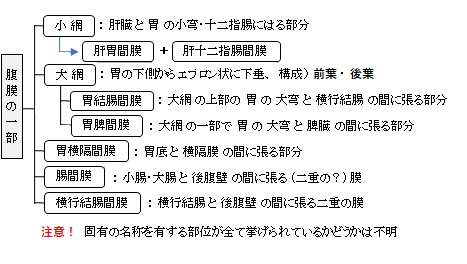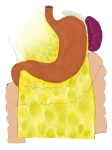
腹 膜:(peritoneum) 腹腔および骨盤腔の腔壁の内面とその中の臓器の表面を覆う漿膜


「 日本人体解剖学 (下巻) 」には以下のような解説文が見られる。 」には以下のような解説文が見られる。
「 長いものは骨盤腔にまで達し、短いものは横行結腸のすぐ下で終わる。小児期までは、大網の前葉は胃壁に連結し、紅葉は体壁に連結し、その間には網嚢の続きが入るが、成人の大網では、紅葉は横行結腸の前面に付着し、ここより以下では前・後両葉は合して1枚となっている。」


■ 感染・炎症予防 ■
血管周囲にリンパ球が集まることにより最近やウイルスによる感染の予防効果がある。また、大網は同じ位置に固定されているわけではなく移動性に優れているため、炎症ヶ所を包み込むことによって、その炎症が他へ広がるのを予防する働きがある。
■ 脂肪の蓄積 ■
大網には脂肪を蓄積する働きがある。その脂肪の蓄積によって、外部からの衝撃によって腸などの内臓などを保護する働きも十分に考えられる。

【 その他 】
・ 胃結腸間膜 ( gastrocolic ligament ) : 胃の大弯と横行結腸の間の腹膜のこと
・ 胃横隔間膜 ( gastrophrenic ligament ) : 胃底と横隔膜を結ぶ腹膜の一部
・ 胃脾間膜 ( gastrosplenic ligament ) : 胃の大弯と脾臓を結ぶ腹膜の一部
以下は「 Wikipedia 」の解説文となる。
「 The greater omentum ( also the great omentum, omentum majus, gastrocolic omentum, epiploon, or, especially in animals, caul) is a large apron-like fold of visceral peritoneum that hangs down from the stomach. It extends from the greater curvature of the stomach, passing in front of the small intestines and doubles back to ascend to the transverse colon before reaching to the posterior abdominal wall. The greater omentum is larger than the lesser omentum, which hangs down from the liver to the lesser curvature. The common anatomical term "epiploic" derives from "epiploon", from the Greek epipleein, meaning to float or sail on, since the greater omentum appears to float on the surface of the intestines. It is the first structure observed when the abdominal cavity is opened anteriorly.[1]
【 語 句 】
・ visceral peritoneum : 臓側腹膜 ・ greater curvature : 大弯 ・ small intestines : 小腸 ・ posterior abdominal wall : 後腹壁 ・ lesser omentum : 小網 ・ lesser curvature : 小弯 ・ abdominal cavity : 腹腔
【 Structure 】
The greater omentum is the larger of the two peritoneal folds. It consists of a double sheet of peritoneum, folded on itself so that it has four layers.
The two layers of the greater omentum descend from the greater curvature of the stomach and the beginning of the duodenum. They pass in front of the small intestines, sometimes as low as the pelvis, before turning on themselves, and ascending as far as the transverse colon, where they separate and enclose that part of the intestine.
These individual layers are easily seen in the young, but in the adult they are more or less inseparably blended.
The left border of the greater omentum is continuous with the gastrosplenic ligament; its right border extends as far as the beginning of the duodenum.
The greater omentum is usually thin, and has a perforated appearance. It contains some adipose tissue, which can accumulate considerably in obese people.
【 語 句 】
・ duodenum : 十二指腸 ・ pelvis : 骨盤 ・ transverse colon : 横行結腸 ・ enclose : 取り囲む ・ inseparably : 密接に ・ gastrosplenic ligament : 胃脾間膜 ・ adipose tissue : 脂肪組織 ・ accumulate : 蓄積する
【 Subdivisions 】
The greater omentum is often defined to encompass a variety of structures. Most sources include the following three :[2][3]
The splenorenal ligament ( or lienorenal ligament ) ( from the left kidney to the spleen ) is occasionally considered part of the greater omentum.[4][5] It is derived from the peritoneum, where the wall of the general peritoneal cavity comes into contact with the lesser sac between the left kidney and the spleen ; the splenic artery and vein pass between its two layers. It contains the tail of the pancreas, the only intraperitoneal portion of the pancreas, and splenic vessels. One or more of the preceding sentences incorporates text in the public domain from the 20th edition of Gray's Anatomy (1918)
【 語 句 】
・ subdivisions : 細分化 ・ define : 定義する ・ encmpass : 取り囲む、含む ・ diaphragm : 横隔膜 ・ synonymous : 同義の ・ spleen : 脾臓 ・ kidney : 腎臓 ・splenorenal ligament : 脾腎ひだ ・ derive from ~ : ~に由来する ・ pancreas : 膵臓 ・ intraperitoneal : 腹腔内の
【 Phrenicosplenic ligament 】
The phrenosplenic ligament ( lienophrenic ligament or phrenicolienal ligament ) is a double fold of peritoneum that connects the thoracic diaphragm and spleen.[6]
The phrenicosplenic ligament is part of the greater omentum. Distinctions between the phrenicosplenic ligament and adjacent ligaments, such as the gastrophrenic, gastrosplenic and splenorenal ligaments, which are all part of the same mesenteric sheet, are often nebulous.[6]
【 Blood supply 】
The right and left gastroepiploic arteries ( also known as gastroomental ) provide the sole blood supply to the greater omentum. Both are branches of the celiac trunk. The right gastroepiploic artery is a branch of the gastroduodenal artery, which is a branch of the common hepatic artery, which is a branch of the celiac trunk. The left gastroepiploic artery is the largest branch of the splenic artery, which is a branch of the celiac trunk. The right and left gastroepiploic arteries anastomose within the two layers of the anterior greater omentum along the greater curvature of the stomach.
【 語 句 】
・ phrenosplenic ligament : 横隔脾ひだ ・ distinction : 区別、特徴 ・ nebulous : 不明瞭な ・ gastroepiploic arteries : 胃大網動脈 ・ celiac trunk : 腹腔動脈 ・ gastroduodenal artery : 胃十二指腸動脈 ・ common hepatic artery : 総肝動脈 ・ splenic artery : 脾動脈 ・ anastomose : 吻合する
【 Development 】
The greater omentum develops from the dorsal mesentery that connects the stomach to the posterior abdominal wall. During its development, the stomach undergoes its first 90° rotation along the axis of the embryo, so that posterior structures are moved to the left and structures anterior to the stomach are shifted to the right. As a result, the dorsal mesentery folds over on itself, forming a pouch with its blind end on the left side of the embryo. A second approximately 90° rotation of the stomach, this time in the frontal plane, moves structures inferior if they were originally to the left of the stomach, and superior if they were originally to the stomach's right. Consequently, the blind-ended sac (also called the lesser sac) formed by the dorsal mesentery is brought inferiorly, where it assumes its final position as the greater omentum. It grows to the point that it covers the majority of the small and large intestine.
【 Functions 】
The functions of the greater omentum are :
- ・ Fat deposition, having varying amounts of adipose tissue[7]
- ・ Immune contribution, having of macrophage collections[7]
- ・ Infection and wound isolation ; It may also physically limit the spread of intraperitoneal infections.[7] The greater omentum can often be found wrapped around areas of infection and trauma. 」
【 語 句 】
・ dorsal mesentery : 総背側腸間膜 ・ axis : 軸 ・ embryo : 胎芽( 妊娠第8週目以前の胎児 ) ・ consequently : 結果として ・ fat deposition : 脂肪沈着 ・ contribution : 寄与、貢献 ・ Infection : 感染 ・ isolation : 隔離、分離 ・ trauma : 外傷
【 参考になるサイト 】
・ イラストや写真を掲載しているサイト-Ⅰ
・ イラストや写真を掲載しているサイト-Ⅱ
・ イラストや写真を掲載しているサイト-Ⅲ
・ イラストや写真を掲載しているサイト-Ⅳ
・ イラストや写真を掲載しているサイト-Ⅴ( 人体標本 )

|